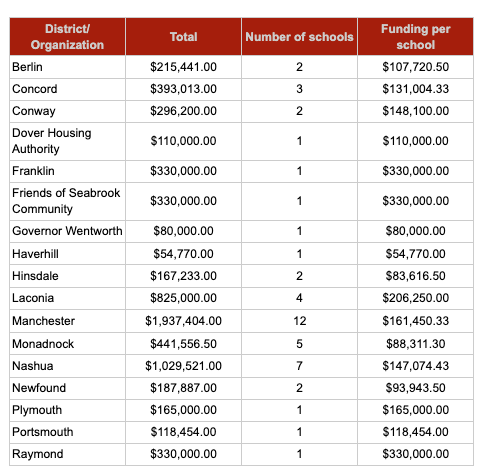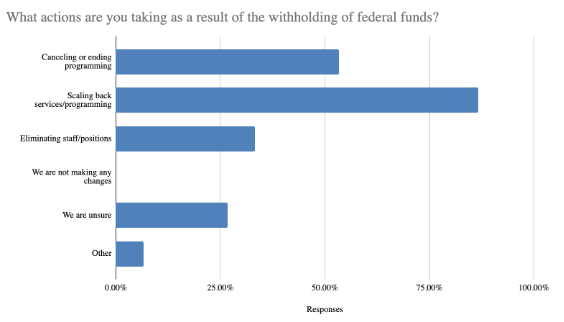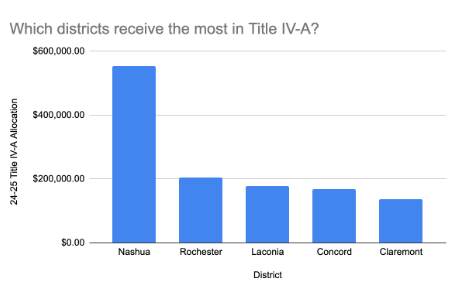Federal funding is (mostly) safe this year, but what might the future look like?
September 3rd, 2025
As teachers and students return to school, federal lawmakers are returning to Washington to decide on funding allocations for the next fiscal year. The consequences for education could be significant.
The Trump administration has made no secret of its desire to shut down the Department of Education. The president’s FY 2026 budget proposal, though unlikely to be enacted as written, suggests a 15% cut to education funding, with significant reductions to funding streams many K-12 schools rely on.
New Hampshire schools got a preview of what this could look like earlier this summer, when, a day before allocated federal funds were set to be released to school districts, the US Department of Education announced it would be pausing disbursements to ensure alignment with the administration’s priorities. Though the administration has since announced it will release the funds, the delay did not come without consequences. In some cases, districts lost out on summer professional development opportunities or had to pause hiring processes. And though districts now should have access to the money they expected, the volatility of the federal funding process may lead districts to rethink some of their investments, or force them to raise funds from other sources.
Reaching Higher NH surveyed 16 district leaders immediately after it was announced that the federal government would be withholding funds. Their answers shed light on what might be at stake for students and families in this unpredictable funding environment.
How much money did NH have at stake?
According to the Learning Policy Institute, a total of $25 million was being withheld from New Hampshire schools, accounting for more than 17% of the total funding New Hampshire receives from the US Department of Education for K-12 schools. Federal funding accounts for approximately 10 percent of school funding in NH.
What funding was being withheld?
The primary funding streams affecting NH districts were:
-
Title II-A: These grants support teacher training and professional development, and many district leaders told us that these grants are the primary or sole source of their funding for professional development. In 2024, NH received a total of $10.8 million in Title II-A funding. More than 80% of the districts we surveyed cited Title II-A as their biggest concern.
-
Title IV-A: The second biggest concern among district leaders we talked to, these grants support student achievement by funding tutoring and mentoring programs, allowing schools to purchase critical technology and materials, and supporting enrichment programs. In 2024, NH received $6.6 million in Title IV-A funding.
-
Title IV-B: Districts identified as high-need can use Title IV-B funding to support before- and after-school and summer programs for students. In 2024, NH received $6.5 million through Title IV-B.
Which districts would have been most affected?
Almost every district in NH receives some funding through Titles II-A and IV-A. The charts below show where those funds were concentrated in the 2024-25 school year. For the two main funding streams – Title II-A (teacher PD) and Title IV-A (enrichment) – we provide two ways of looking at the data: both total dollars received and dollars per student. Unsurprisingly, the biggest districts tend to receive the most funding overall, but analyzing dollars per student can help show which districts rely most on these funds to provide their current level of service.

According to NH Department of Education data, Title IV-B funds for outside-of-school-time programs in the 2025-26 school year will flow to 47 schools in 17 districts. (In some cases, the funds flow through a community based organization to a school.)

Why are these funding streams important?
Title II-A
Title II-A funds support high-quality teachers, teaching, and instruction. Districts we surveyed primarily use Title II-A to fund professional development, instructional coaching, and leadership training. One district leader told us the II-A is the only way the district can pay educators for the time they spend in trainings. Professional development both strengthens the educator workforce and drives improved student outcomes. One district leader shared:
“Title II-A funding is a lifeline for our professional development efforts. With a very limited annual budget, and as a property-poor town, we work hard to keep local costs down. These federal funds allow our educators to continue learning and growing in ways that directly benefit our students. If this funding is cut, we will be forced to ask our taxpayers to cover the difference—placing additional strain on a community that is already doing more with less.”
And professional development is not just a luxury. Teachers are required to engage in training to maintain their licenses, and state law mandates several annual trainings that districts must pay for. For many districts, Title II-A funds are critical to remaining in compliance with state laws.
Title IV-A
Funds from Title IV-A are used to support educational opportunities and student health and safety. A few examples of how NH districts have used these funds:
-
Supporting a student success coordinator position
-
Launching STEM programs, such as science clubs and hands-on learning opportunities
-
Hiring school security officers
-
Running after school enrichment programs
-
Purchasing evidence-based technology and curricular materials
One leader said of their Title IV-A funds: “We’ve used these funds to supplement our reading and math programs as well as science for additional resources for teachers and students that were not included in our budget. We will no longer be able to purchase these.”
What did the delay mean for districts?
Many of the leaders we surveyed said they had already been forced to make cuts based on the delay in receiving promised funding. Contracts with instructional coaches were delayed; staff hours were reduced; training opportunities were cancelled; and in at least one district, outside counseling services offered to families were cut. One leader told us, “We have already had to cancel multiple professional development sessions, and we are currently unable to offer learning opportunities aligned with our strategic goals.”

Source: Reaching Higher NH Survey, June 2025. Note that the survey was administered before the federal government announced the release of funding.
What happens if these funds are delayed or rescinded next year?
Among leaders who responded to our survey, the primary concern was student outcomes. “These grants are impacting our most needy students and families and putting our staff in positions of not being able to learn and grow to better meet student needs,” one leader said.
If, as the administration has promised, these funding streams shrink moving forward, districts will need to make up the balance from state or local funds. That is not an easy prospect, and given the timing of different districts’ budget cycles, some may need to start planning now for a scenario where funds are delayed, allocations are smaller, or funding streams are cut completely.
Even with funding available for 2025-26, administrators are worried about the future. We followed up with survey respondents in August to see how they are thinking about next year, and heard that administrators are considering whether they will have to ask voters to support the programs once supported by the federal government. At a time when many school budgets are already strained, this could mean the end of programs critical to students and educators.
Follow us on Facebook, Instagram, and LinkedIn, and join the New Hampshire Education Network (NHEN), our network of New Hampshire parents, educators, business leaders, and community members to stay up to date on the latest developments in education policy.


